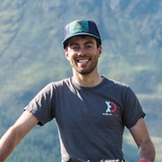Blog
stories • happenings • adventures
Desert Dreams and Ghost Cows – Fastest Rookie Time Ever on the AZT with Huw Oliver
Going in to the AZT300, my main aim was simply to be present, be confident in myself and to find that elusive state of mind that makes ultra-racing so utterly addicitive. Annie and me spent a full month in Arizona, spending some time with Kurt Refsnider and Kaitlyn Boyle, the respective male and female record holders of the 300 (and the 750 for Kurt), and getting some top notch information on what to expect and how to go about putting together a successful rookie run on the trail.
For both of us, our main concerns were heat and water. In Scotland, I don’t think I’ve ever really ridden with anything larger than a 750ml bottle, and if one source is dubious or dry, there will always be another clear stream or lochain within an hour or so. And the issue is usually a lack of heat rather than an overabundance of it! The forecast was set to be on the warm side of normal, and we knew that 100 fahrenheit (38 degrees C) was on the cards, although thankfully the wet winter meant that water sources on the route would be at their most plentiful. Still, stretches of 50 to 70km without water were a mental hurdle, as water is so much less negotiable than food, and we were very keen not to make tits of ourselves by running out of it. I spent the drive down to the Mexican border memorising a crib sheet with mileages, timings and notes to hopefully make such critical pieces of resupply easier in the fug of heat and fatigue.
The other issue was food. Resupplies on the AZT300 aren’t exactly plentiful, and I was hoping for a schedule that could have me missing the critical halfway resupply at Summerhaven while the small store was still shut… After that there is nothing on route to Picketpost, 140 miles away. To play it safe, I packed the 16,000 calories I estimated that I needed on to my bike and back, along with the 4.5 litre water capacity that would be my maximum. I might not have taken much gear, but the food and water added up to a heavy bike as we camped down at Parker Canyon Lake one Wednesday night in April, anxious and excited for the start early the next morning…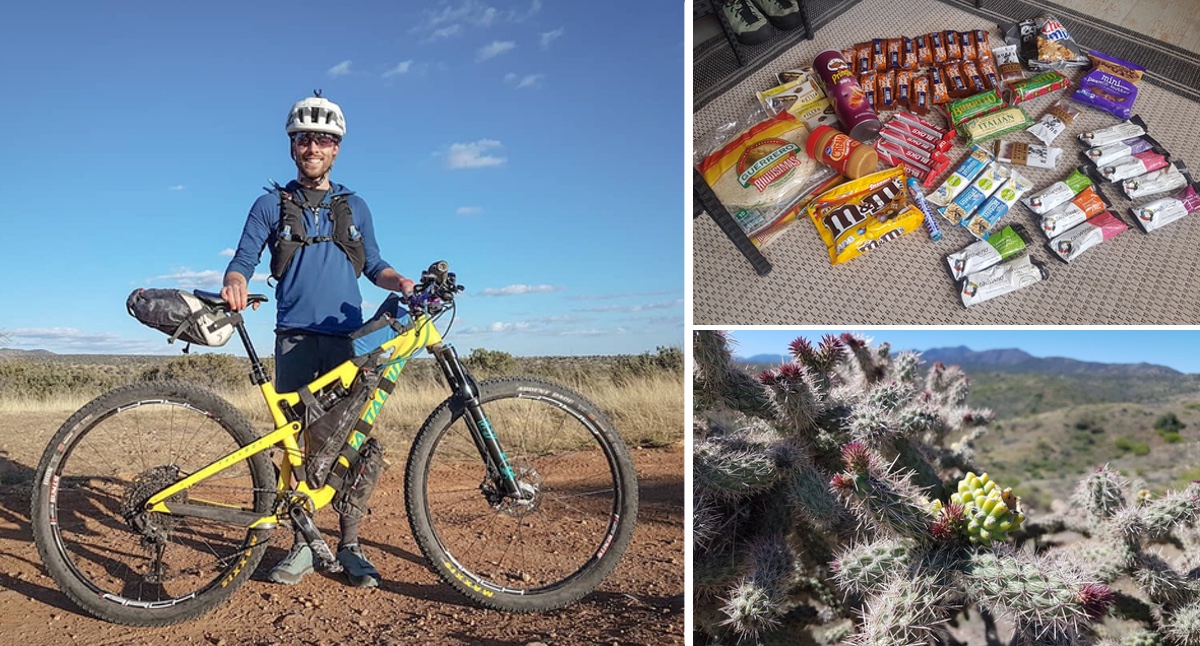
The Canello Hills
The atmosphere at the start was the familiar blend of nerves, last-minute packing and people catching up. After a brief welcome from John the organiser, at 8am about 40 riders had the awkward job of filing straight into the singletrack. The AZT route, despite the fact that bikes have to divert around Wilderness Areas, has an incredible amount of singletrack, most of which is going steeply up or down. The route makes this clear straight away, launching into loose descents and punchy, steep climbs. I knew that the temptation would be to cave in to nerves, excitement and legs fresh from a week of tapering to burn through way too many matches, too early on. Just as Kurt had predicted, this is exactly what a dozen or so of the other racers preceded to do, passing me one after another as I twiddled up the climbs with a tiny 28t chainring. One guy asked to come by from the back of the group because his 36t cassette wasn’t allowing him to go this slow! The second part of Kurt’s prediction had been that I would see many of these guys at Patagonia, only 30 miles (10%) of the way in, strung out and exhausted after getting too hot and too tired in the Canellos. I reckoned I could pick out who that would be from the grunts and wild bursts of power up the short climbs, and tried my best to settle into a patient rhythm to save those fresh legs.
 In Among the lovely scrub oak forest, vague washes and occasional cows of the Canellos, I looked over my shoulder with a mouth full of burrito to see Neil Beltchenko arriving, who had started on the border itself with the other 750 riders, an hour earlier than us. I had been expecting him to catch me, but not this soon, and after a brief minute or two chatting he got the singlespeeder ahead of us in his sights and zipped off, again surprisingly quickly. Even after the initial nerves got themselves out of their system, it took a constant, conscious decision to stick to the ‘plan’ and keep eating, drinking and pedalling easy, until I rolled out of the Canellos and into Patagonia slightly ahead of schedule, keen to restock with water quickly and keep on moving. As predicted, there were small groups of tired-looking bikers spread among patches of shade outside the shop on the main street.
In Among the lovely scrub oak forest, vague washes and occasional cows of the Canellos, I looked over my shoulder with a mouth full of burrito to see Neil Beltchenko arriving, who had started on the border itself with the other 750 riders, an hour earlier than us. I had been expecting him to catch me, but not this soon, and after a brief minute or two chatting he got the singlespeeder ahead of us in his sights and zipped off, again surprisingly quickly. Even after the initial nerves got themselves out of their system, it took a constant, conscious decision to stick to the ‘plan’ and keep eating, drinking and pedalling easy, until I rolled out of the Canellos and into Patagonia slightly ahead of schedule, keen to restock with water quickly and keep on moving. As predicted, there were small groups of tired-looking bikers spread among patches of shade outside the shop on the main street.
The Santa Ritas
It was getting into the afternoon by the time I hit the dirt road out of Sonoita and began the steady climb into the Santa Ritas, and I could feel the heat beginning to leave the fun zone and enter the melty zone. Food was hard to eat, and even short climbs had me working at what felt like an unsustainable rate. I always find the chopping, changing and inconsistent pacing, of the early miles of these things a bit stressful though, so I was at least glad to be on my own and out of sight of anyone else in front or behind, but as I felt the time slipping away from me on legs that were overheating I longed for the release of sunset. The first sunset is usually the time when what starts as a race becomes an adventure, and what at first needs determined thought and concentration becomes fluid and thoughtless, all in the pursuit of forward motion. I wanted the excitement and energy that comes when the race against other riders stops and the race against the clock begins.
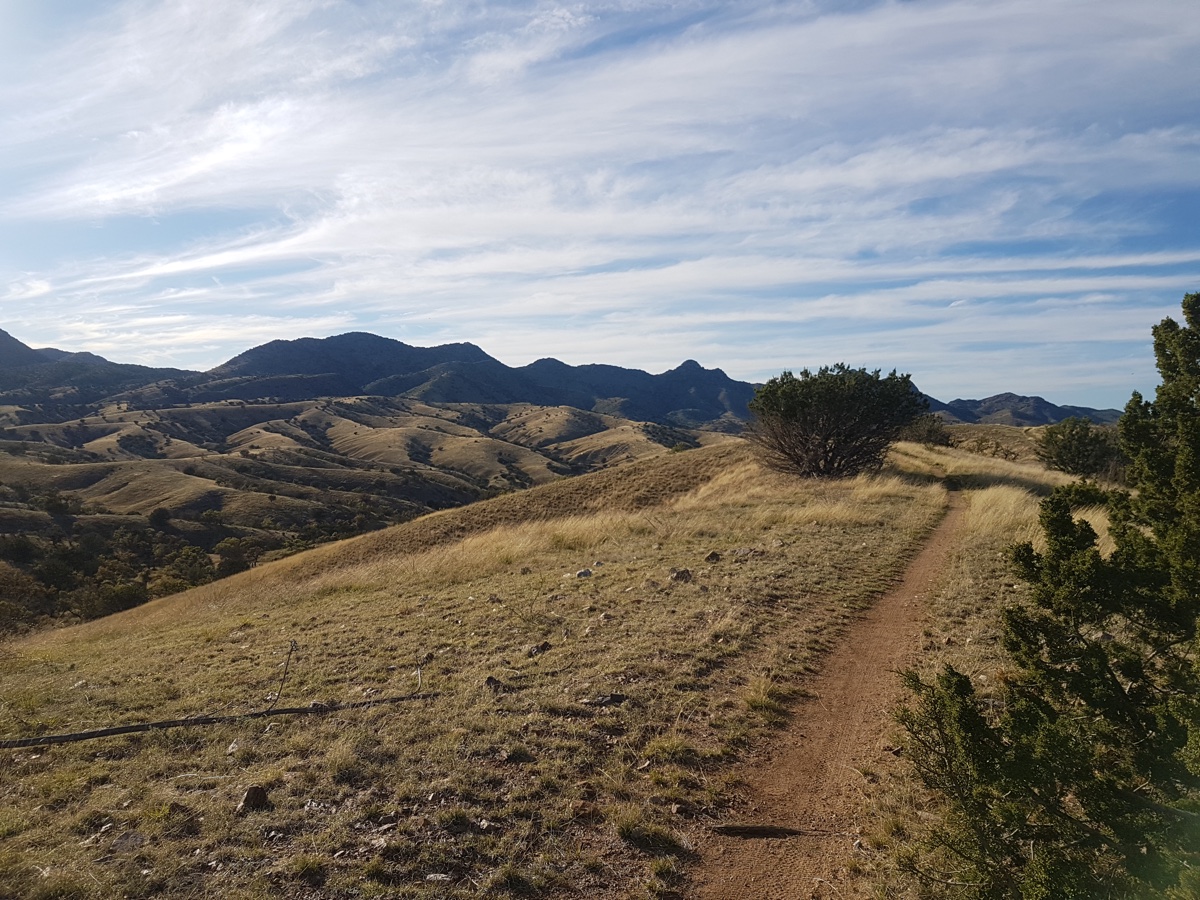
Somewhere in the Santa Ritas.
The Sonoran Desert
The sun finally set on me as I crested the last climb of the Santa Ritas, now thoroughly tired of the heat, the relentless punchy climbs, and the burritos that I’d been munching on all day, spicy burps included. I couldn’t really tell if I had succeeded in pacing well through the first 80 miles, because my legs felt toasted regardless thanks to the heat. Almost as soon as the sun set, though, a second wind emerged (or was that just the burritos?), and perhaps it was from that point that I did manage to stop worrying about what I was doing, and just get on with doing it.
After all the punchy climbing of the first day, the 20 mile descent to Tucson is one hell of a reward. Just ‘down’ enough to make you feel like a hero, but not so fast as to require too much concentration: one of the most beautiful pieces of trail I have ever ridden, although the combination of a desert sunset and excitement to be plunging into the first night of the race might have helped. Normally the nights feel intimidating in an ultra, but as my body cooled down and a full moon rose over the horizon, I felt euphoric. When it came down to it, we had all chosen to be there, and I was determined to enjoy as much of the experience as possible. Cold pockets began to settle into even the shallowest washes, each one like passing through a cold shower, and these felt like an extra treat after the hot afternoon. When it comes down to it, we had all chosen to be here, and I was determined to enjoy as much of the experience as possible.
Just after crossing I10, 100 miles in, I passed another rider, Gerrit, and he later caught me at the water supply at Colossal cave, while I fannied around for 10 minutes in the dark trying to find the spigot that was right next to me all along. A bit of a wake-up call to start taking self-care and decision-making seriously, now that nighttime fatigue was creeping in. I was less than an hour off the 48-hour splits that I’d set myself, but half an hour can easily slip away from you when basic mistakes appear. I filled up at Colossal and nailed some caffeine, and then again at Saguaro National park entrance, before re-joining Gerrit as we scooted around western Tucson on tarmac around 1am, before starting the long Mount Lemmon climb, that begins with Reddington Road…
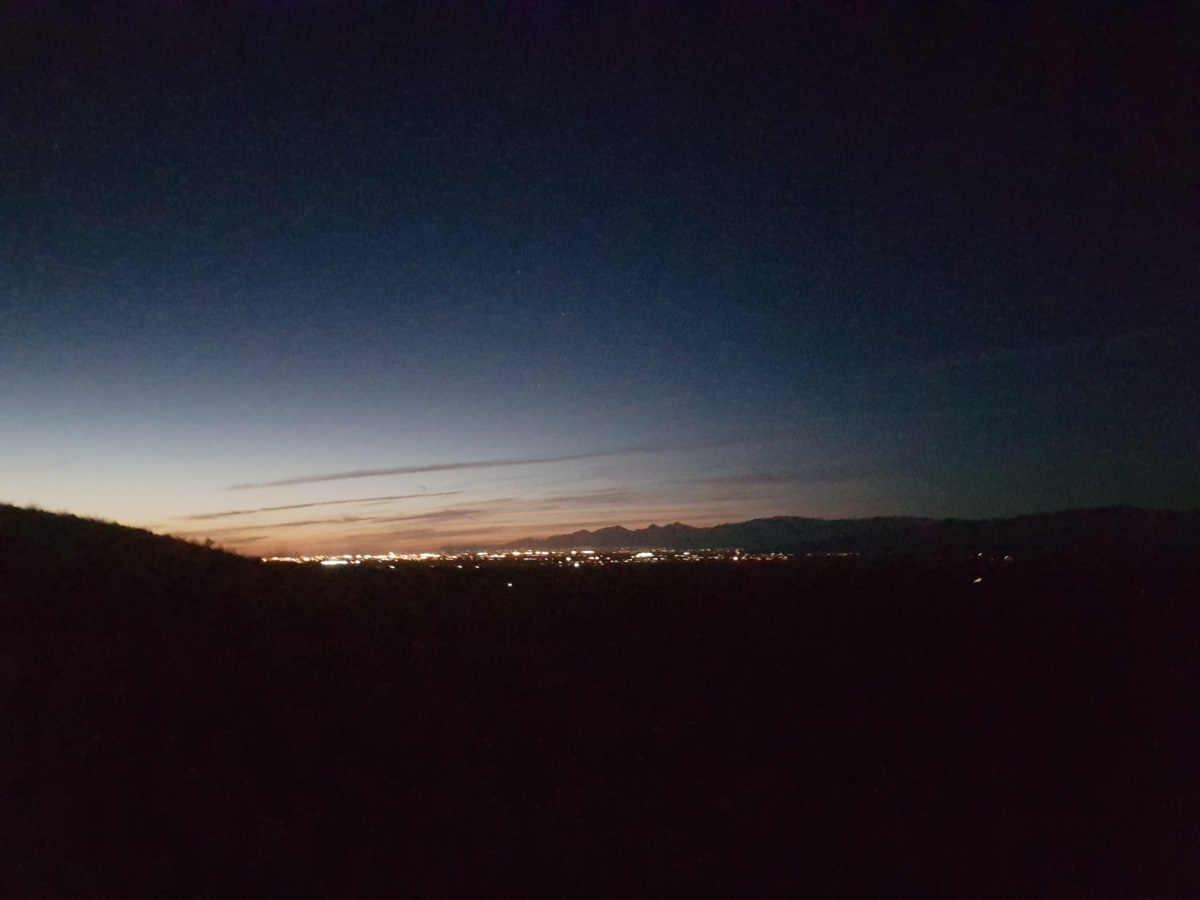
The lights of Tucson, and Mount Lemmon in the background.
Mount Lemmon
From the low point on the edge of Tucson, at just over 700m, it is nearly 50 miles of rolling, varied and sometimes infuriating climbing to the village of Summerhaven at 2,400m. The first few miles up Reddington Road were a respite from the day’s relentless singletrack, just gravel grinding in the cool of the night, and a nice opportunity to actually have a conversation while we had the chance. Once we turned off the road and onto the jeep track at mile 133 though, things were back to punchy with a capital ‘P’. The bedrock rollercoaster of gnarly 4×4 track was hard to follow in the dark, a maze of split lines and stream crossings that made it difficult to eat and easy to get frustrated. I tried to slip into the zen state of just riding what I could see (not much in the dark) and not to worry about the slow rate of progress. I sensed that Gerrit was working perhaps a little too hard on the climbs, and towards the end of the section he slipped back from me into the night, and I re-crossed the road alone at 3.30 in the morning.
I could see a light a few miles ahead of me heading through Molino Gap, as well as the faintest glow of dawn breaking behind me on the skyline. As good as that felt, water was becoming an issue, and I looked forward to the water tank that I was expecting just before the hike-a-bike to the gap. I stupidly passed a perfectly good creek, thinking that I would take water as late as possible to avoid hefting extra weight up the hike, but when I got to the site of the tanks marked on my map, there was nothing but a bone dry creek bed. I wasted a good few minutes searching around in the dark, but there was no water there. It was below me, and I felt like a right spanner. My plan had been to water up, and then take a short sleep on Molino gap itself, above the cold air pockets in the washes. So much for that plan.

Oracle Ridge stretching into the distance.
I felt thirsty, but awake, so the best plan seemed to be to push on and hope to be able to beg some water at Molino campground, or find a creek on the climb after it. Dawn broke as I crossed the gap, and the mental boost from having ridden right through the first night stoked me up enough to ride all but one chute on the descent down to the highway. Still high from that, it was with relief that I hit a creek on the steep singletrack paralleling the highway, and set off into the second morning feeling ready to see this last section of climbing away.
The heat came quickly with the return of the sun, and I got a shock an hour or two up the road when I found John Lackey sat in a layby, sipping a Coke. He told me had started feeling a funny misstep in his heartbeat during the night, and didn’t want to push his luck in the heat, deciding to scratch. He seemed pretty upbeat about things, considering, and then told me that this made me the head of the race, which was a surprise! I had been convinced that I was fifth or sixth, and I hate the idea of checking a tracker during the ride, so climbed on feeling split between pleased and nervous at the idea of having a lead to defend. It seemed easier not to think about it all, so instead I had some more horrible, horrible cereal bars for breakfast to take my mind off it.
I think it’s important at this point to talk about the new detour away from the highway, just before reaching Summerhaven. After 9 hours of climbing, with a critical resupply just an easy spin away, what I really don’t fancy doing is diving down into a drainage, pissing away hundreds of metres of hard-earned altitude, only to pick my way along a badly washed out, vague bit of trail to whom ‘flow’ is some distant cousin. I’m not sure if I walked or biked more. Either way, we were not amused. Everyone will have their two cents on this section, but mine is that tarmac is not inherently bad, as long as it serves a purpose. Within grasping distance of a hard-fought summit and food shop doesn’t seem like the time for an inefficient bit of exploring, if you ask me. Okay, rant finished (unless the detour remains in future).
Neil caught me again when I did at last make Summerhaven, looking fresh but saying he wasn’t feeling it. I wanted to stop longer, ask about how his night went and about the place we found ourselves riding in, but as I had packed food so as not to rely on Summerhaven’s shop, I only needed a couple of minutes to down a Coke and then went to do some ‘personal admin’ in the public toilets. When I was done I had no idea if Neil was behind or had jumped ahead, but either way my path led to the infamous Oracle Ridge. I had heard a lot about it, mostly spoken in tones of trepidation, but figured that technical sections are always going to suit me more than the pedally bits, so if it was hard there should at least be a time advantage in it for me. The view, as promised by Kaitlyn, was breathtaking: a looong look out to the north from Mount Lemmon’s lonely granite heights, taking in mile upon mile of flat (well, flat-looking; that idea would be debunked later) desert to the north, all of which would need to be crossed. The ridge itself was chunky with a capital C, with some good bits of riding in among some less good (spiky) bits, before dropping precipitously off the end of the ridge on a rubbly double-track that was like surfing on steeply inclined coconuts, which then gave way to some primo singletrack as I landed in the desert some 1,500m below.
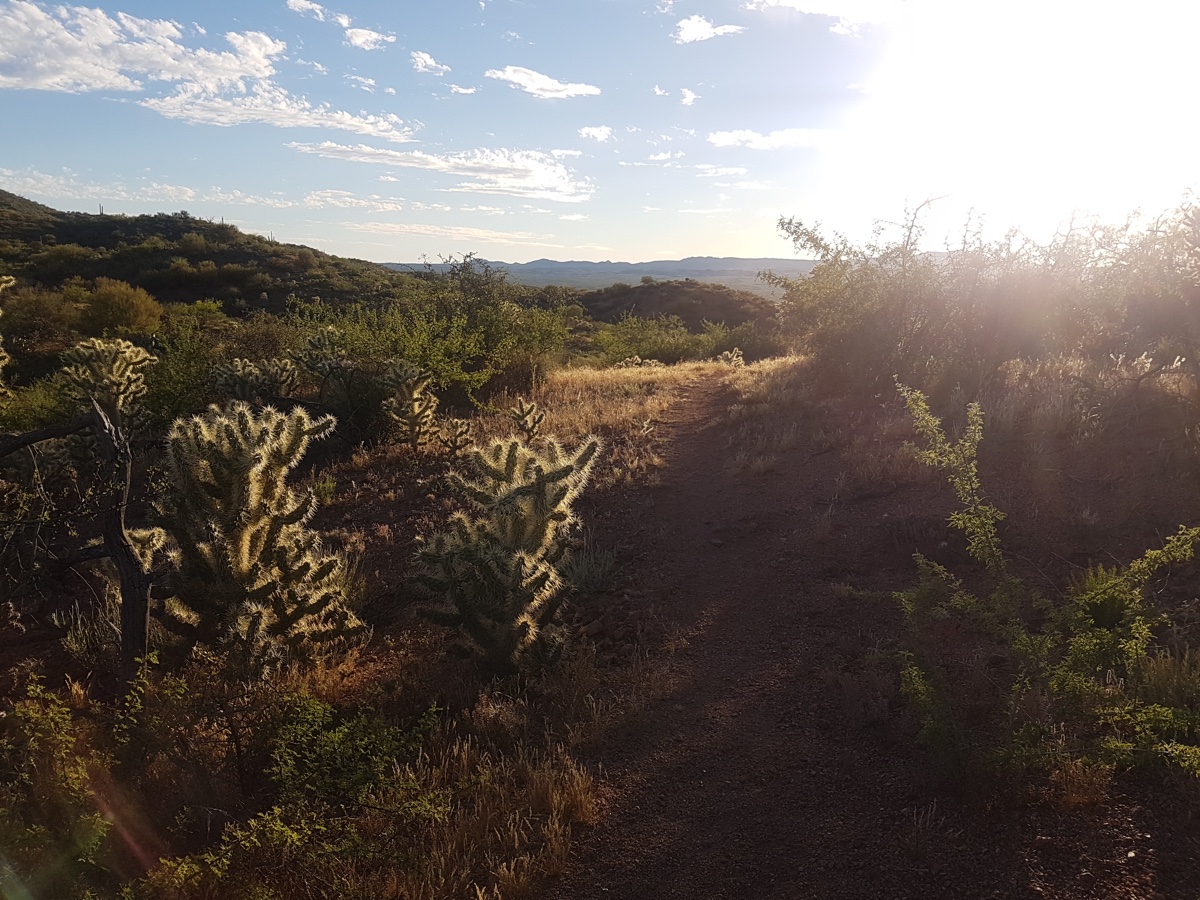
STF’s: Spiky Trail Features.
The ‘Big Three’
Touching down abruptly after the long descent, I was already aware that I was too hot, and I hadn’t even been pedalling for a while. It was early afternoon, and by the time I got to Tiger Mine Road and its water cache I was feeling sluggish and having difficulty eating, just like the day before. Even moderate efforts felt unsustainable, so as frustrating as it was I backed off more and more, until I was crawling along but at least feeling as though I might make it to the finish. Between here and there were the ‘Big Three’: three roughly thirty mile sections, each with very limited water and virtually all on singletrack. The thought of another long, hot afternoon stretching ahead on slow, technical trail wasn’t the best, but on the flip side I was now the only rider on the ‘homeward’ side of Mount Lemmon’s halfway hump, so what had worked for me this far would get me to the finish, if I could listen to my body and give it what it needed, which right now was a huge, cold milkshake. Warm water from the cache would have to do.
The thirty miles from Tiger Mine Road were hot, hilly and slow. The trail looped its way in and out of every single wash, some were shallow, but others were tens of metres deep, and I soon lost track of my overall direction. Nothing was flat, everything was slow, and I was roasting in the afternoon sun. Even the toughest section of the route had its moments though: a Spanish guy touring the trail, who insisted on taking a picture and shouting that all of us racers were ‘heroes!’; the meditative of not caring how fast I was moving, so long I was moving; the low light refracting in the needles of thousands of cholla cactus as sunset drew nearer. When it did finally start to set I was nearing Antelope Peak, and caught up with Ty Hopkins at a gate. All afternoon I had been following a solitary tyre track that I was convinced belonged to Neil, trying and failing not to get distracted by it – it hadn’t ever occurred to me that an ITT rider (not part of the group start) might be ahead of me, but here was the answer to my pondering! Ty had started the night before the group, had a nightmare with a slashed tyre in the Canellos, and now here we were in the middle of the desert.

Antelope Peak on the skyline, temperature 10,000 degrees (left). The Cholla Gardens (right).
Ty made for great company, and I was glad for it. Our paces were similar, and to an extent so were the stories we swapped from the trail: heat, thirst and the beauty of the desert. The conversation was punctuated by my newfound ability to lean a hand or a knee into hidden cacti on the corners, with one prickly pear going right through my shoe into my foot. I don’t know where this skill came from all of a sudden, but picking spines out of my knuckles soon became tiring, and I had to apologise to Ty from the sudden yells and pitstops. With my original plan to grab 30 minutes’ sleep on the first night having been abandoned with the non-existent water tank, I decided to get a pre-emptive nap at freeman Road, the next water cache, before I started suffering too much from the deprivation. Ty decided to do the same, and we arrived around 9pm, just as the cool night air was beginning to make me feel alive again. I didn’t feel sleepy yet, but didn’t want the sleep monster to eat me, so I put on a windproof, set the alarm for 15 minutes’ time and lay down in the grass beside the trail…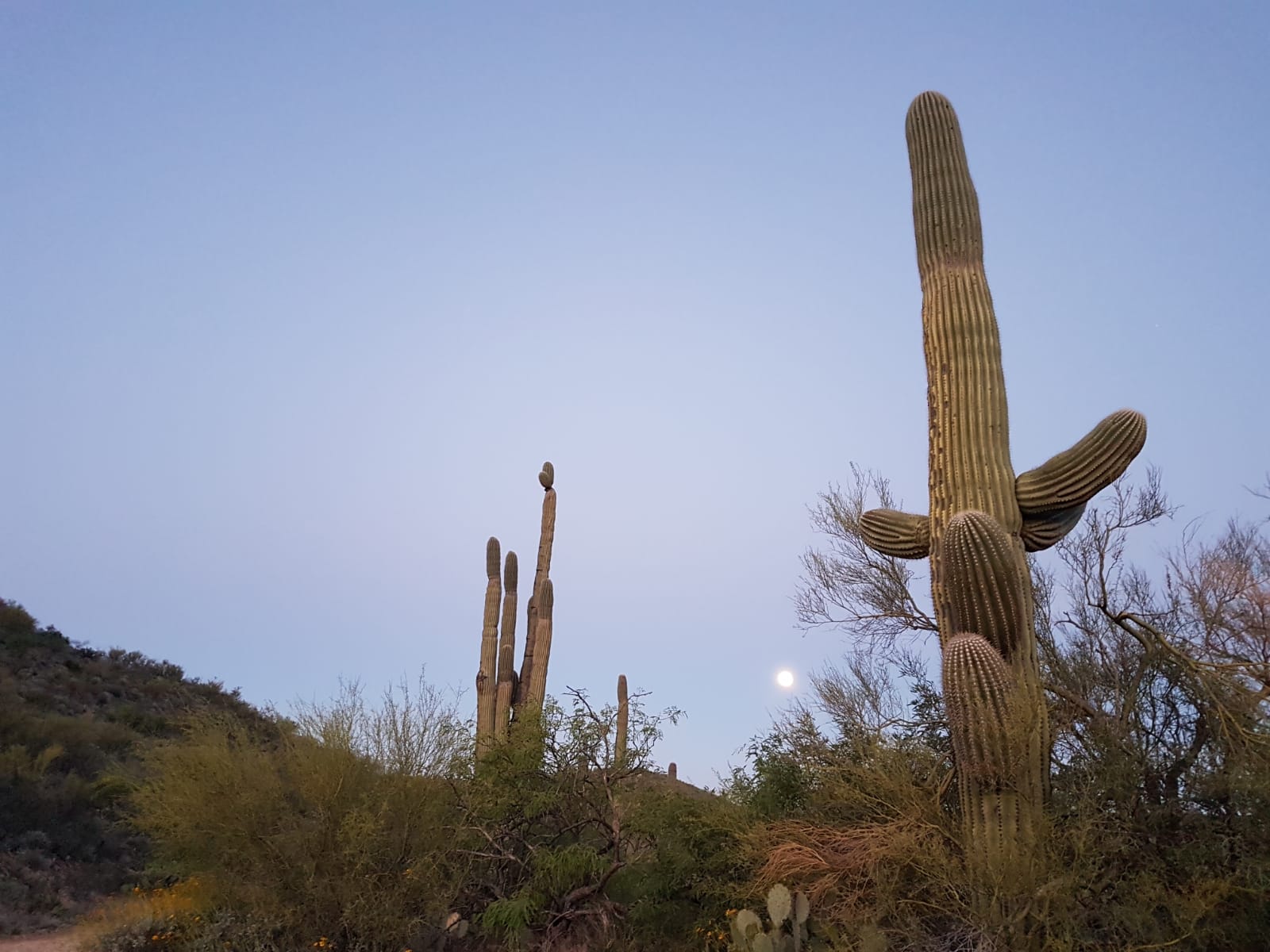
3 seconds later, the alarm went off. I could have sworn I hadn’t been asleep, but apparently I was no longer a good judge of that. I regretted the decision to sleep immediately: from feeling alright before the nap, I now felt like the entire 36 hours of riding had caught up with me in one go, and about as alert as a reanimated corpse. Ty was still asleep in the bushes somewhere, so I got on my bike and tried to wolf down some food at the same time as waking myself up. One swerve into a cactus achieved that very quickly. Still, one of the Big Three down, two to go.
Thankfully, the next ‘boulders’ section to the bridge over the Gila River was probably the best of the route. With no idea what was around me or what was coming, there was little to do but stick like glue to the twisting, diving sliver of trail that disappeared at the edge of my light’s beam. It was hero-gradient again, reminiscent of the descent to Tucson the night before. Miles fell away with minimal pedalling where momentum could be kept through the corners; I felt so immersively connected to the trail and my bike that there was no need to question what happened outside the pool of light, only to lean into the corners and stop leaning when the trail looked like straightening up. A curious thing happens on the trail when you’ve been on it long enough: though fatigue should make technical riding sluggish and disjointed, tiredness is overtaken by the composed flow state that I found myself in then, mistakes become impossible, and an exhausted body can put out some of the best riding of its life. Controlled euphoria is perhaps the right way to describe it, and you’ll know it if you’ve felt it.
The local wildlife was coming out for some dot-watching, too. Kangaroo mice jumped between my wheels more than once, but my favourites were the ‘baby owls’. They were birds whose name I’ve been told and since forgotten, but which liked to sit their small, grey bodies right slap in the middle of the trail, pretending to be a rock until you were right on top of them, when they would fly off and cause you to either have a heart attack or question the last functioning bits of your brain.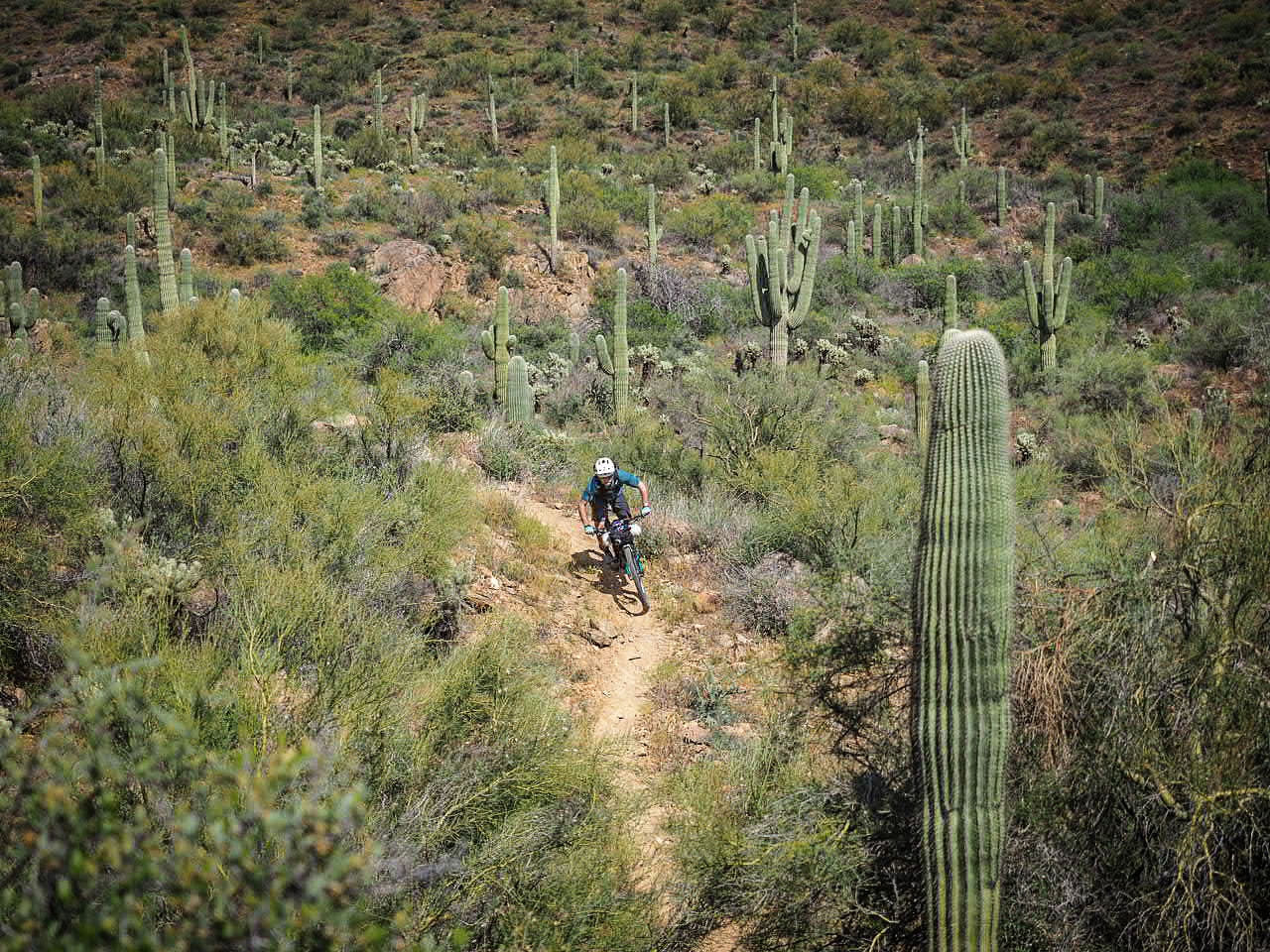
All highs come to an end, and between the soft sand of Ripsey Wash and the climb on to the ridge the momentum was knocked out of me. Life felt hard again. Among the various spiky plants, most of which I had now had inserted into my hands, knees, shins or arms, I began to see things. The ‘best’ one was the Ghost Cow, which popped up at least half a dozen times, always on the edge of my vision. Not a proper ghost cow — I was hallucinating a regular cow with a sheet over its head, and eye-holes, like a bad Halloween costume. I’m not sure I want to pull on the thread of psychological meaning with that one. Ghost cows aside, I was having a bad time again by the time I gained the crest of Ripsey Ridge. The descent from the ridge is probably incredible in a more lucid state, but its continuous ups and downs, exposed traverses and switchbacks were getting to be too much for my sleep-deprived brain. I saw a couple of tarantulas scuttling across the trail, questioned whether they were real or just another ghost cow, and only just skidded to a stop in time to avoid squashing them. By the time I reached the Gila it was 3am on my second night, I could barely stay awake, and with the knowledge that it was now two down, one to go, I set a 15 minute timer and tried to reset my brain for the last push to Picketpost.
The nap did the trick. I was thoroughly sick of all my food, my teeth hurt, and my legs ached, but my brain was back in the game enough to enjoy the fast descents on the rollercoaster trail along the Gila. I had been able to see a long way back from the summit of Ripsey, and there had been no other lights glinting in the desert’s darkness. I was alone, which in the darkness before the dawn is how I would rather be: free of distractions, riding rather than racing. When the glow of dawn began to filter through behind me, it was around 5am, and I had been riding for 45 hours with thirty minutes of rest. It was uncharted territory for me, and knowing that my own envelope of experience and confidence had grown in the last two days was just as much of a boost as the return of the daylight. I was glad to have gotten through the Gila section in the pre-dawn cold, as I knew it wasn’t a nice place to be in the heat, and I didn’t envy the folks behind me.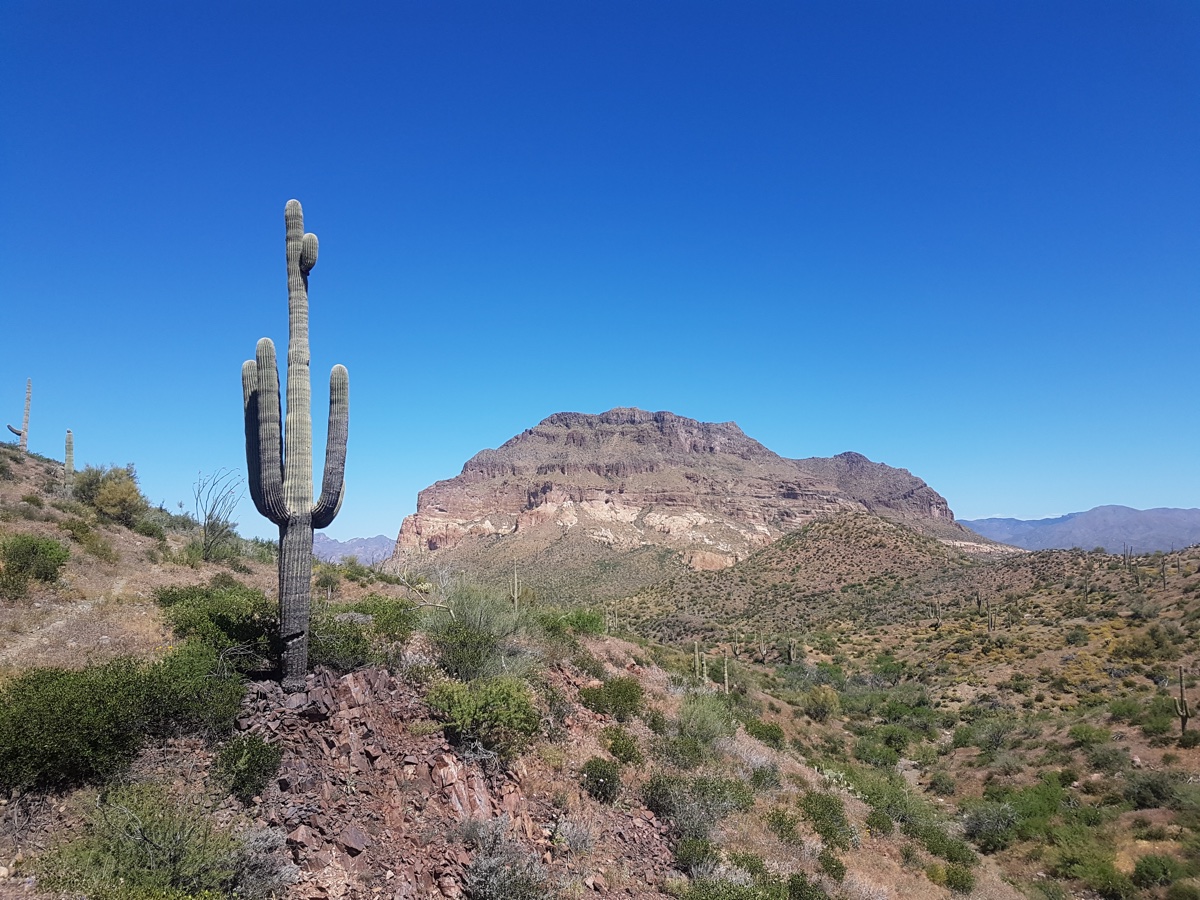
Picketpost Mountain
The heat soon caught up with me in the south-facing cauldron of the climb away from the river. I’d filled all of my 5 litre water capacity at Kelvin, so I didn’t feel the need to take water from the muddy river, but I knew it might be a little tight in the heat. It felt like the time for rationing energy and concentration was over, and the twenty miles to the finish were going to be like squeezing the last drops from a lemon. The climb itself is beautiful, but offers no clue of what’s to come if you don’t know it. It sneaks further and further back into the canyon, over rises and false summits, until a long, alpine-feeling traverse opens up and shows the distant summit, with plenty of descending and re-climbing between here and there. I had given in to the desire to be finished and out of the heat by the time I crested the pass at 10am.
The last descent is a sucker-punch to the gut of weary bike-riders. I’m pretty sure it’s a net climb from the top to the finish, whatever the topo maps say. I’d fully had enough after the first few climbs, and decided to stop overthinking it and just empty the tank. Go out with a bang. Something like that. It worked, too, to an extent. The weightless flow of the night before came back, or a shadow of it, but this time it was the joy in the burning of muscle, the feeling of hot air filling my lungs, and dwindling supplies of blood sugar. Picketpost Mountain had appeared between the saguaro cacti, the pace went higher and higher, and I didn’t care any more.
3 miles from the finish I came around a corner and met Kurt, Kaitlyn and Karen, who had ridden up the trail to see me in. At first I was a little disoriented by having to stop and say hi, unsure if I wanted to exchange pleasantries when this still wasn’t finished. They told me to get on with it.
I rolled into the trailhead at 11.45, 51 hours and 45 minutes after starting at Parker Canyon Lake. Kurt told me that it was the fastest rookie time ever posted, as well as being the first time a non-American had won the race. Times on clocks are great and everything, but I’d rather have fun than go fast, any day. Luckily, those two things tend to happen together, although right then the litre of chocolate milk Kaitlyn had pulled from the cooler meant a lot more to me than that. The clock had stopped, and finally so could I.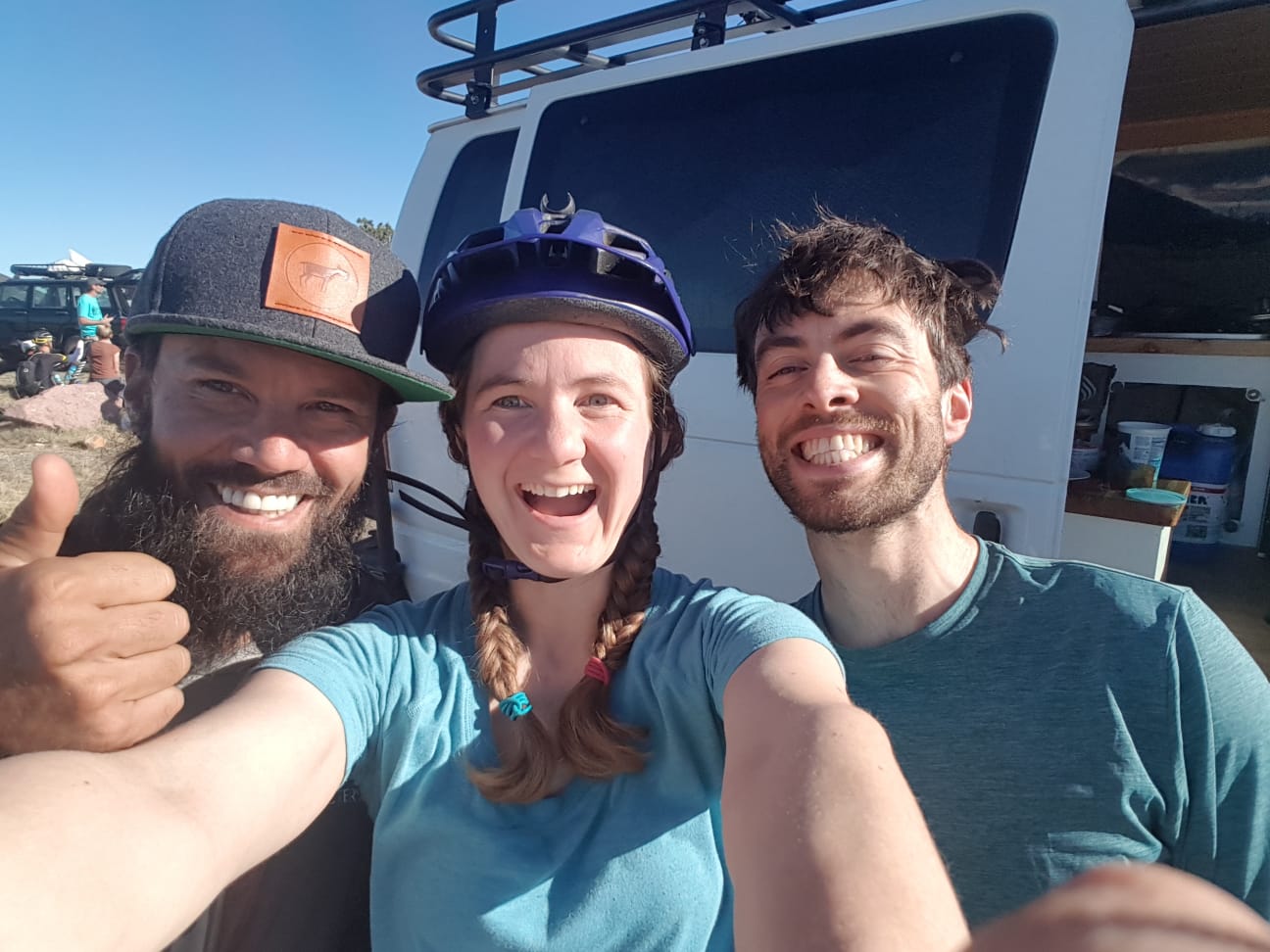
Huw’s favorite thing to read is a map – when he moved across the border to Scotland, the first thing he did was buy one. Bikes are a good way to check that the map wasn’t lying, and the resulting trips have taken him to nearly every bog in Scotland, to Patagonia, Nepal and Arctic Lapland. The odd bikepacking race thrown in for good measure keeps him honest. More recently, the addition of a packraft meant that even the blue bits of the map are fair game! Occasionally, he works as an outdoor educator and mountain bike coach, hoping to show other people why they ought to read more maps, too. His blog is Topofests.com.

